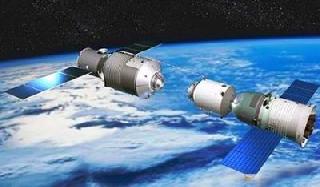
Animation of the Tiangong 1 module (left) and a Shenzhou capsule (right) in orbit.
BEIJING (PTI): China successfully carried out the second docking of two unmanned spacecraft, as part of an ambitious plan to set up its own space station by 2020.
China's Shenzhou-8 unmanned spacecraft Monday re-docked successfully with Tiangong-1, a module of the country's planned space lab, state-run Xinhua news agency said.
About half-an-hour before, the Shenzhou-8 had successfully disengaged from Tiangong-1 after a 12-day flight together and later re-docked again.
The Shenzhou-8, launched on November 1, docked with the Tiangong-1 module on November 3 in an orbit 343-km above Earth, marking China's first space docking. Tiangong-1 has been in orbit since its launch on September 29.
After the second docking, Shenzhou-8 will disengage itself once again and return back home.
The docking mechanism, composed of up to 10,000 parts, and the more than 600 instruments aboard Shenzhou-8 were all developed and made by China, Wu Ping, spokeswoman for China's manned space programme, said at a previous press conference.
The Shenzhou-8 is set to return to Earth on the evening of November 17, Wu said.
The experiments were part of China's plan to establish its own space station by 2020 to rival Mir, the Russian space station currently being operated by Russian and US space agencies.
Currently, China is training team of men and women astronauts to go on experimental mission to stay in the station next year.
The success of the docking procedure made China the third country in the world, after the United States and Russia, to master the technique, moving the country one step closer to establishing its own space station.
 Previous Article
Previous Article













The Indian Air Force, in its flight trials evaluation report submitted before the Defence Ministry l..
view articleAn insight into the Medium Multi-Role Combat Aircraft competition...
view articleSky enthusiasts can now spot the International Space Station (ISS) commanded by Indian-American astr..
view article